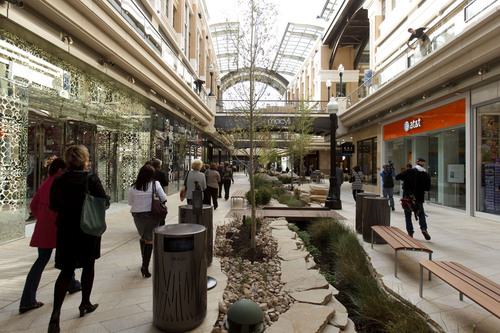This is an archived article that was published on sltrib.com in 2014, and information in the article may be outdated. It is provided only for personal research purposes and may not be reprinted.
Five years ago there wasn't much to do on Salt Lake City's Main Street unless you wanted to buy a kilt from Edinburgh Castle. From the giant craters next to Temple Square to the empty storefronts stretching south, the city's historic central business district looked war-torn.
But downtown never lost its support system, including its largest institutional resident, the Church of Jesus Christ of Latter-day Saints.
In the middle of the Great Recession — when virtually no one in the country was willing to invest in a large retail shopping center, let alone one in an urban core — leadership at the LDS Church pushed ahead with what they knew would be not only a grand entry to their own headquarters but also a key catalyst of the most important center of commerce in Utah.
It was a commitment that is hard to overstate. It may take decades before the church recovers its investment in the $1.5 billion-plus City Creek Center, but those will be decades when all Utahns benefit from that commitment.
The church and the rest of downtown's supporters got to cheer this week with the release of the 2014 State of Downtown report from the Downtown Alliance. It showed that downtown sales set a record by exceeding $800 million last year, and that record owes much to City Creek Center, which not only brings in millions itself but also has triggered a hoped-for turnaround in the rest of downtown.
And it's not just stores. The office vacancy rate declined last year, and the number of downtown residents continues to rise, driven by both young people and retirees wanting a piece of the vibrant central core. With a new performing arts complex and a convention hotel in the works, entertainment and tourism have never been more central to downtown's success.
Challenges remain. The same report issues a warning about the city's impact fees, which are intended to fund infrastructure for new downtown residents but are high enough to dampen development. There are still too many empty street-level spaces and parking lots, and a walk through Pioneer Park when it isn't a Farmers Market or a Twilight concert still shows plenty of big-city social problems.
City planners are trying to get in front of those issues with the recent release of a 25-year downtown community plan. Called "Story of Our Future," the plan focuses on taking downtown to a 24/7 metropolis that accommodates work, play and everything in between.
Recent history shows the city can face that future with optimism.



